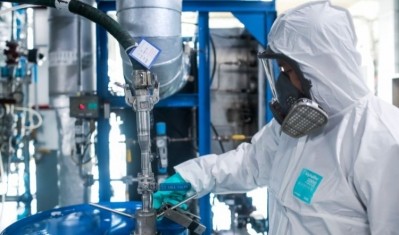Promotional Features
AI transforms route scouting for faster drug synthesis
Small molecule drugs are becoming increasingly complex and that poses serious challenges for timely investigational new drug applications.
This complexity is being driven by various factors, including efforts to make treatments more effective and to avoid side-effects, targeting new modes of action, and improving target specificity. The greater complexity of such drugs means that drug developers have to contend with longer synthetic pathways. In 2006, the average number of steps in the synthesis process was eight; this has now grown to be commonly in excess of 20 steps.1,2
With longer synthetic routes, there are additional challenges for chemists to meet the demands of an active pharmaceutical ingredient (API) manufacturing process that is capable of being highly productive, as well as ensuring quality and reproducibility. Additionally, a higher number of process steps places a greater strain on the supply chain to provide the necessary raw materials and intermediates.
The longer synthetic routes can then lead to a major problem for drug developers: extended timelines for the development and optimisation of small molecule drugs before being ready for investigational new drug (IND) applications. Any hindrance that occurs at the pre-IND stage can have an outsized impact, making the overall R&D process more costly, extending the potential time to market of a treatment, and, ultimately, resulting in a delay to patient’s access to the final product.
Scouting ahead
Route scouting is where these issues can arise and be addressed. The process is a critical part of the synthesis of APIs, wherein the aim is to identify the most efficient synthetic pathway to produce the product and evaluate multiple possible routes to determine the best approach. There are a number of goals that need to be considered when selecting the optimal pathway:
- Optimise Yield and Purity Find a synthesis route that maximises the yield and purity of the final product
- Minimise Steps and Complexity Identify the shortest and simplest pathway to reduce the number of steps, which in turn lowers costs and the potential for errors
- Assess Scalability Ensure that the chosen route can be efficiently scaled up from laboratory to industrial production
- Evaluate Safety and Environmental Impact Select a route that minimizes hazardous reagents and waste, reducing environmental impact and ensuring safety during production
- Reduce Costs Identify a cost-effective route that uses readily available and affordable raw materials and reagents
These challenges require sophisticated solutions, especially as the trend for complex small molecules is likely to remain and only develop further. This is where the use of AI tools to automate parts of the route scouting process can provide significant advantages over traditional retrosynthetic analysis alone. Computer-assisted synthesis planning tools allow for predictive and analytical cheminformatics to identify the most efficient synthesis routes. AI tools allow in silico retrosynthesis technologies, supply chain analyses, and process R&D to be evaluated based on vast data sets, allowing for the proposal and comparison of different routes in an automated manner.
The major advantages of the AI-enabled approach are broad, including the accelerated exploration of pathways, the identification of non-intuitive solutions, time and cost savings, and enhanced decision-making. This is driven by the ability of AI to rapidly evaluate numerous routes far more quickly than is possible solely with human experts, using available data to support conclusions. AI systems can identify the potential synthesis routes through various modes of action, such as through retrosynthetic analysis, data mining, machine learning, molecular simulations and modelling, multi-objective optimisation, and continuous learning.
Step-by-step analysis
At Lonza Small Molecules, AI-enabled route scouting takes place over three distinct phases. In the first phase, the different innovative and efficient route options are prioritised. In the second phase, sourcing intelligence is consolidated to give clients a decision on the top priority routes that have emerged from the first phase. Finally, in phase three, process research and development is conducted to affirm the effectiveness and performance of the top-rated, client-nominated process routes that will go ahead into the laboratory.
Broadly, classification and prioritisation questions are centred on two categories, which are commercial and technical. The type of query these categories will answer could be whether a raw material supply chain is ready for a rapid startup, or whether a plan addresses specific problematic features of an API. By posing these kinds of demands on the process, it is possible to create structured, decision-enabling reports that consolidate the insight generated through the AI route scouting combined with the expertise of the human element of the team.
Despite AI providing crucial insights, the latter part of the route scouting process is essential. It is only through the experience of the scientists working in collaboration with the AI that practical insights can be delivered. An effective team will ensure that the selected routes are efficient, practical, and safe for large-scale production.
Gaining an edge
Real-world experience is crucial to ensure that the automation provided by the AI is practical. At Lonza Small Molecules, this means applying decades-worth of supply chain data, alongside informatics expertise. This allows Lonza and its clients to understand the actual costs of sourcing starting materials and intermediates.
By utilising this commercial supply chain information, the scientists on the team are able to visualise the commercial viability of the routes that are being generated. This includes understanding the global supply situation for each of the building blocks that make up a potential product, including total production volume and global suppliers. Through this commercial data, manufacturing decisions can be made based on accurate and up-to-date costs and sourcing options, without the need to rely on potentially inaccurate public pricing data.
When AI-enabled route scouting is combined with an experienced team and a wealth of commercial supply chain information, it is possible to avoid many of the pitfalls that can occur to companies when pursuing potential routes. With its cohesive approach, Lonza Small Molecules is able to proactively plan a robust and commercially effective manufacturing process. The result is costly changes to processes and delays can be avoided, which allows clients’ projects to move quickly through the route design and development process, bringing therapies to patients in need at speed.
References
1. Carey, J.; Laffan, D.; Thomson, C, et al. (2006). Analysis of the reactions used for the preparation of drug candidate molecules. Organic & Biomolecular Chemistry. Issue 6.
2. Eastgate, M.; Schmidt, M.; and Fandrick, K. (2017). On the design of complex drug candidate syntheses in the pharmaceutical industry. Nat Rev Chem 1, 0016.







